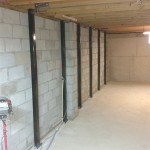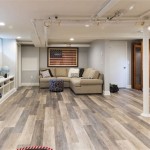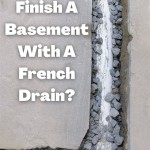How To Deal With Mold In A Basement
Mold in a basement is a common problem for homeowners, posing potential health risks and property damage. Basements, often damp and poorly ventilated, create ideal conditions for mold growth. Understanding the causes, identifying mold, and implementing effective remediation strategies are crucial for maintaining a healthy and safe living environment. Addressing mold promptly can prevent it from spreading to other areas of the home, ultimately minimizing the scope and cost of the problem.
The presence of mold indicates an underlying moisture issue. Ignoring mold growth can lead to structural damage as mold feeds on organic materials like wood and drywall. In addition, prolonged exposure to mold spores can exacerbate respiratory problems, allergies, and other health concerns, particularly for individuals with pre-existing sensitivities, children, and the elderly. Therefore, a proactive approach to mold prevention and remediation is essential for responsible homeownership.
Identifying Mold in Your Basement
Mold manifests in various colors and textures, including green, black, white, and brown. It often appears as spots or patches on walls, floors, ceilings, or other surfaces. A musty or earthy odor is another common indicator of mold growth, even if the mold itself is not immediately visible. These odors are produced by microbial volatile organic compounds (MVOCs) released by the mold.
Visually, mold can range from small, isolated spots to large, sprawling colonies. It can have a fuzzy, slimy, or powdery texture. Common areas for mold growth in basements include near leaky pipes, around windows, on concrete walls, and in areas with poor ventilation. Condensation on cold surfaces, such as pipes and concrete, can also create the moisture needed for mold to thrive.
To confirm the presence of mold, visual inspection is often sufficient. However, in cases where mold is hidden or difficult to access, mold testing kits or professional air sampling may be necessary. These tests can identify the specific type of mold present and its concentration in the air. Professional mold inspectors use specialized equipment to detect moisture levels behind walls and in other concealed areas, providing a more comprehensive assessment of the situation.
Differentiating mold from mildew is also important. Mildew generally appears as a white or gray powdery substance that grows on the surface of materials. It is typically easier to remove than mold and less damaging. However, mildew can still cause aesthetic issues and should be addressed to prevent it from progressing into a more serious mold problem. Regular cleaning and improved ventilation can often control mildew growth.
Addressing Moisture Sources
Controlling moisture is paramount to preventing and remediating mold growth in a basement. Identifying and addressing the source of moisture is the first and most crucial step in any mold remediation strategy. Without eliminating the underlying moisture problem, mold will inevitably return, regardless of how thoroughly it is cleaned.
Common sources of moisture in basements include leaky pipes, foundation cracks, poor drainage, high humidity, and condensation. Plumbing leaks should be repaired promptly. Foundation cracks, even hairline fractures, can allow water to seep into the basement and should be sealed with appropriate waterproofing materials. Improving the exterior drainage around the foundation directs water away from the building, reducing the risk of water intrusion.
High humidity levels can be addressed with dehumidifiers. These devices remove excess moisture from the air, creating a less favorable environment for mold growth. A dehumidifier's capacity should be appropriate for the size of the basement and the severity of the humidity problem. Regular monitoring of humidity levels with a hygrometer can help maintain optimal conditions, ideally below 60% relative humidity.
Proper ventilation is essential for reducing moisture buildup. Opening windows (when weather permits) and using fans can improve airflow and promote drying. Ensuring that laundry appliances, such as dryers, are properly vented to the outside prevents moisture from accumulating in the basement. Consider installing exhaust fans in bathrooms or other areas prone to high humidity.
In addition to identifying and addressing moisture sources, consider implementing preventative measures such as basement waterproofing. This can involve applying a waterproof coating to the interior or exterior of the foundation walls, installing a sump pump to remove excess water, and creating a vapor barrier to prevent moisture from migrating through the concrete slab.
Mold Remediation Techniques
Once the moisture source has been addressed, the next step is to remediate the existing mold. The scope of the remediation will depend on the extent of the mold growth. Small areas of mold, less than 10 square feet, can often be cleaned by homeowners using appropriate precautions. Larger areas or significant infestations may require professional mold remediation services.
For DIY mold cleaning, it is essential to wear personal protective equipment (PPE) to minimize exposure to mold spores. This includes a respirator mask rated N-95 or higher, gloves, and eye protection. Covering exposed skin with long sleeves and pants is also recommended.
Effective mold cleaning solutions include diluted bleach (1 part bleach to 10 parts water), vinegar, and commercially available mold cleaners. When using bleach, ensure adequate ventilation and avoid mixing it with other cleaning agents, as this can create hazardous fumes. Test any cleaning solution on a small, inconspicuous area first to ensure it does not damage the surface.
Apply the cleaning solution to the affected area and scrub thoroughly with a brush or sponge. For porous materials like drywall or wood, it may be necessary to remove and replace the affected sections if the mold has deeply penetrated the material. After cleaning, allow the area to dry completely. Ensure that the cleaned surfaces remain dry to prevent recurrence.
Professional mold remediation services utilize specialized equipment and techniques to remove mold safely and effectively. They often use air scrubbers with HEPA filters to remove mold spores from the air, and they may employ containment measures to prevent the spread of mold to other areas of the home. Professional remediators also have the expertise to identify and address hidden mold growth behind walls and in other inaccessible areas.
Following any mold remediation, it is crucial to monitor the area regularly for signs of recurrence. Inspect for any new moisture sources and address them promptly. Maintaining good ventilation and humidity control will help prevent future mold growth. Consider applying a mold-resistant sealant or paint to surfaces that are prone to moisture exposure.
Preventative measures are key to maintaining a mold-free basement. Regularly inspect the basement for signs of moisture or mold growth. Clean and dry any spills or leaks immediately. Ensure that gutters and downspouts are functioning properly to direct water away from the foundation. Consider insulating pipes to prevent condensation. By taking proactive steps to control moisture and maintain a healthy basement environment, homeowners can minimize the risk of mold problems and protect their health and property.

Simple Preventative Tips To Keep Mold And Mildew Out Of Your Basement Waterproof Com

How To Remove Mold From Your Basement Live Science

How To Remove Mold From Basement Walls In 2024

Stop Mold From Lurking In Your Basement

How To Remove Mold Black In Basement

Basement Mold Have You Concerned Solutions

What Is White Mold And Why It In Your Basement Real Homes

What You Need To Know About Mold From Basement Flooding

6 Warning Signs Of Mold In Your Home And Tips To Prevent It Zander Solutions

10 Ways To Prevent Mold In The Basement
Related Posts







